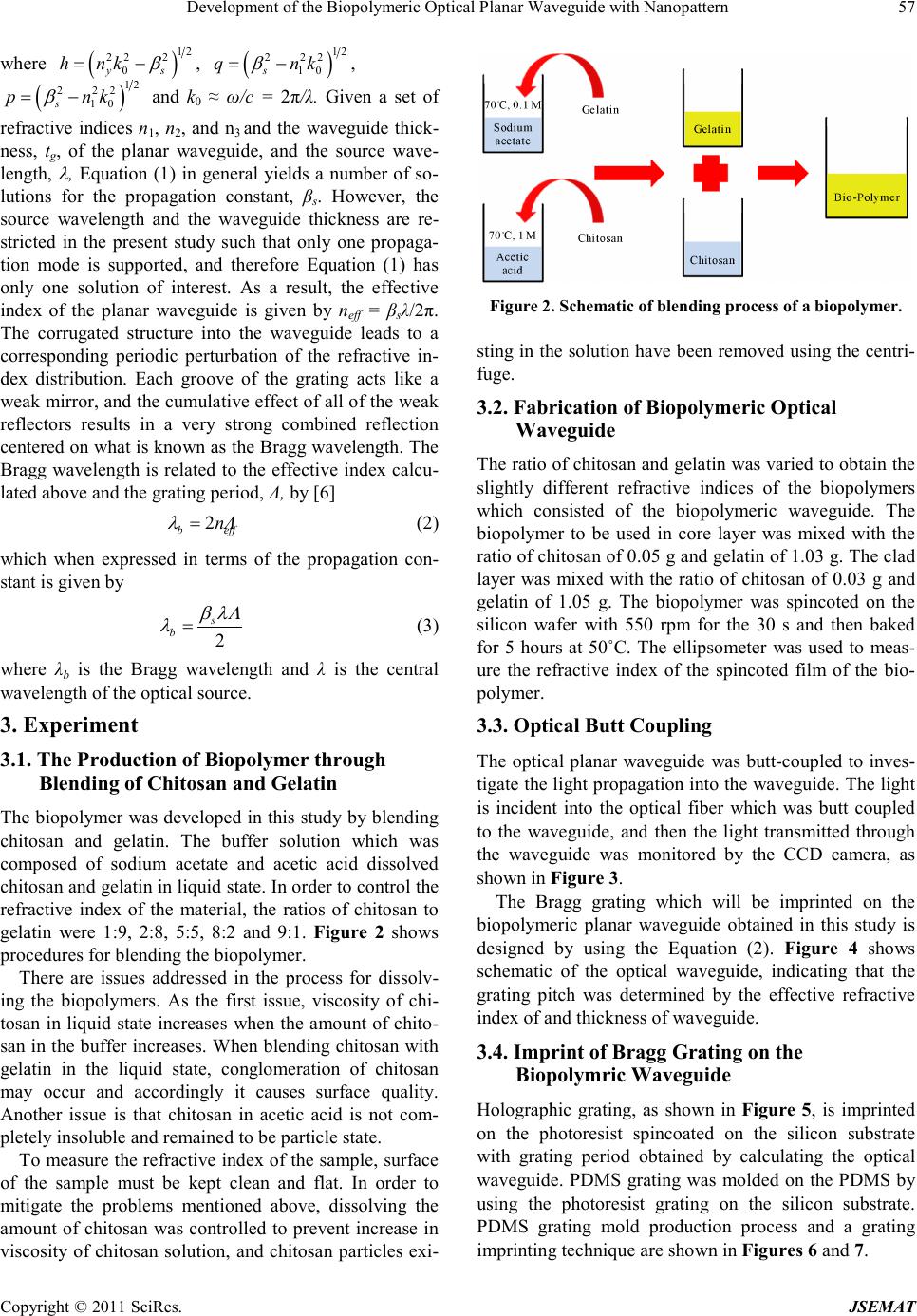
Development of the Biopolymeric Optical Planar Waveguide with Nanopatter n
Copyright © 2011 SciRes. JSEMAT
where
,
,
and k0 ≈ ω/c = 2π/λ. Given a set of
refractive indices n1, n2, and n3 and the waveguide thick-
ness, tg, of the planar waveguide, and the source wave-
length,
λ
, Equation (1) in general yields a number of so-
lutions for the propagation constant, βs. However, the
source wavelength and the waveguide thickness are re-
stricted in the present study such that only one propaga-
tion mode is supported, and therefore Equation (1) has
only one solution of interest. As a result, the effective
index of the planar waveguide is given by neff = βsλ/2π.
The corrugated structure into the waveguide leads to a
corresponding periodic perturbation of the refractive in-
dex distribution. Each groove of the grating acts like a
weak mirror, and the cumulative effect of all of the weak
reflectors results in a very strong combined reflection
centered on what i s kno wn as the B ragg wave le ngth. The
Bragg wavelength is related to the effective index calcu-
lated above and the grating period, Λ, by [6]
(2)
which when expressed in terms of the propagation con-
stant is given by
(3)
where λb is the Bragg wavelength and λ is the central
wavel ength of t he optical sour ce.
3. Experiment
3.1. The Production of Biopolymer through
Blending of Chitosan and Gelatin
The biopolyme r was de veloped in this stud y by ble nding
chitosan and gelatin. The buffer solution which was
composed of sodium acetate and acetic acid dissolved
chitosan and gelati n in liquid state. In ord er to co ntrol the
refractive index of the material, the ratios of chitosan to
gelatin were 1:9, 2:8, 5:5, 8:2 and 9:1. Figure 2 shows
procedures for blending the biopolymer.
There are issues addressed in the process for dissolv-
ing the biopolymers. As the first issue, viscosity of chi-
tosan in liq uid state increase s when the amount of chito-
san i n the buf fer incre ases. W hen ble nding c hitosa n with
gelatin in the liquid state, conglomeration of chitosan
may occur and accordingly it causes surface quality.
Another issue is that chitosan in acetic acid is not com-
pletely insoluble and remained to b e par tic le state .
To measure the refractive index of the sample, surface
of the sample must be kept clean and flat. In order to
mitigate the problems mentioned above, dissolving the
amount of chitosan was controlled to prevent increase in
viscosity of chitosan solution, and chitosan particles exi-
Figure 2. Schematic of blending process of a biopo lymer.
sting in the solution have b een removed using the centri-
fuge .
3.2. Fabrication of Biopolymeric Optical
Waveguide
The ratio of chitosan and gela tin was varied to ob tain the
slightly different refractive indices of the biopolymers
which consisted of the biopolymeric waveguide. The
biopolymer to be used in core layer was mixed with the
ratio of chitosan of 0.05 g and ge lati n of 1 .03 g. The clad
layer was mixed with the ratio of chitosan of 0.03 g and
gelatin of 1.05 g. The biopolymer was spincoted on the
silicon wafer with 550 rpm for the 30 s and then baked
for 5 hours at 50˚C. The ellipsometer was used to meas-
ure the refractive index of the spincoted film of the bio-
polymer.
3.3. Optical Butt Coupling
The optical planar waveguide was butt-coupled to inves -
tigate the light p ropagation into the waveguide. T he light
is incident into the optical fiber which was butt coupled
to the waveguide, and then the light transmitted through
the waveguide was monitored by the CCD camera, as
sho wn in Figure 3.
The Bragg grating which will be imprinted on the
biopolymeric planar waveguide obtained in this study is
designed by using the Equation (2). Figure 4 shows
schematic of the optical waveguide, indicating that the
grating pitch was determined by the effective refractive
index of and thick ness of waveguide.
3.4. Imprint of Bragg Grating on the
Biopolymric Waveguide
Holographic grating, as shown in Figure 5, is imprinted
on the photoresist spincoated on the silicon substrate
with grating period obtained by calculating the optical
waveguide. PDMS grating was molded on the PDMS by
using the photoresist grating on the silicon substrate.
PDMS grating mold production process and a grating
impr i ntin g tec hni que are shown in F igures 6 and 7.